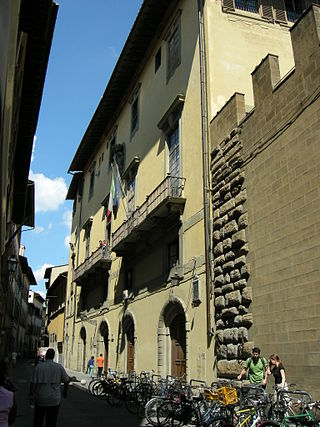
Piazza Navona is a public open space in Rome, Italy. It is built on the site of the 1st century AD Stadium of Domitian and follows the form of the open space of the stadium in an elongated oval. The ancient Romans went there to watch the agones ("games"), and hence it was known as "Circus Agonalis". It is believed that over time the name changed to in avone to navone and eventually to navona.

Palazzo Pamphilj, also spelled Palazzo Pamphili, is a palace facing onto the Piazza Navona in Rome, Italy. It was built between 1644 and 1650.

The Palazzo Barberini is a 17th-century palace in Rome, facing the Piazza Barberini in Rione Trevi. Today, it houses the Galleria Nazionale d'Arte Antica, the main national collection of older paintings in Rome.

Carlo Fontana (1634/1638–1714) was an Italian architect originating from today's Canton Ticino, who was in part responsible for the classicizing direction taken by Late Baroque Roman architecture.

Leonardo Antonelli was an Italian Catholic cardinal.

Francesco Cozza was an Italian painter of the Baroque period.

The Biblioteca Angelica is a public library located in Rome, Italy. In front of the Piazza Sant'Agostino square, adjacent to the church of Sant'Agostino, not far from Piazza Navona.

The Biblioteca Nazionale Vittorio Emanuele III is a national library of Italy. It occupies the eastern wing of the 18th-century Palazzo Reale in Naples, at 1 Piazza del Plebiscito, and has entrances from piazza Trieste e Trento. It is funded and organised by the Direzione Generale per i Beni Librari and the Ministero per i Beni e le Attività Culturali.

The Museo internazionale e biblioteca della musica is a music museum and music library in the Palazzo Aldini Sanguinetti, in the historic center of Bologna, Italy.

The Biblioteca Riccardiana is an Italian public library under the aegis of the Ministry of Culture, located inside the Palazzo Medici Riccardi at 10 Via de’ Ginori in Florence, in the neighborhood comprising the Mercato Centrale and the Basilica di San Lorenzo. Its main feature is preserving books collected by members of the Riccardi family and making them available in the very same rooms that were originally dedicated to that purpose. So, still today the library boasts the magnificent bookshelves, neatly carved and gilded, that create the atmosphere of a late-seventeenth-century patrician library, whose main features have all been kept intact.

The Biblioteca Estense, was the family library of the marquises and dukes of the House of Este. The exact date of the library's birth is still under speculation, however it is known for certain that the library was in use during the fourteenth century. Whilst it was greatly enriched during the Renaissance years in Ferrara, the library was concretely established in Modena in the beginning of the seventeenth century. It is known as one of the most important libraries in Italy. The library is located, along with the Galleria Estense directly below its collection of artworks, in the Palazzo dei Musei in Modena.

The Biblioteca Palatina or Palatina Library was established in 1761 in the city of Parma by Philip Bourbon, Duke of Parma. It is one of the cultural institutions located in the Palazzo della Pilotta complex in the center of Parma. The Palatina Library was named after Apollus Palatinus.

Pelagio Palagi was an Italian painter, sculptor and interior decorator.

The Biblioteca comunale Luciano Benincasa is located in Ancona, Italy, in the Palazzo Mengoni-Ferretti, at the central Piazza del Plebiscito.

The Biblioteca Nazionale Braidense or Braidense National Library, usually known as the Biblioteca di Brera, is a public library in Milan, in northern Italy. It is one of the largest libraries in Italy. Initially, it contained large historical and scientific collections before it was charged with the legal deposit of all publications from Milan. Since 1880, it has had the status of a national library and is today one of the 47 Italian State libraries.
Francesco Girolamo Cancellieri was an Italian writer, librarian, and erudite bibliophile.

The Museo di Roma is a museum in Rome, Italy, part of the network of Roman civic museums. The museum was founded in the Fascist era with the aim of documenting the local history and traditions of the "old Rome" that was rapidly disappearing, but following many donations and acquisitions of works of art is now principally an art museum. The collections initially included 120 water-colours by the nineteenth-century painter Ettore Roesler Franz of Roma sparita, "vanished Rome", later moved to the Museo di Roma in Trastevere.

The Biblioteca Civica Gambalunga, also known as the Gambalunghiana, is a public library in Rimini, in the region of Emilia-Romagna, northern Italy.

The Musei Civici di Padova or degli Eremitani is a complex of museums and historic sites, centered on the former convent of the Eremitani, and its famous Cappella degli Scrovegni with its Giotto fresco masterpieces. The complex is located on Piazza Eremitani, at the edge of the historic center of Padua, region of Veneto, Italy. The complex includes halls of archaeological objects and – in the nearby Palazzo Zuckermann – a museum of modern and medieval applied art.

The Biblioteca Comunale Mozzi Borgetti, founded in 1773, is the public library of Macerata, located on Piazza Vittorio Veneto 2 region of Marche, Italy. The name is sometimes hyphenated as Mozzi-Borgetti.




















